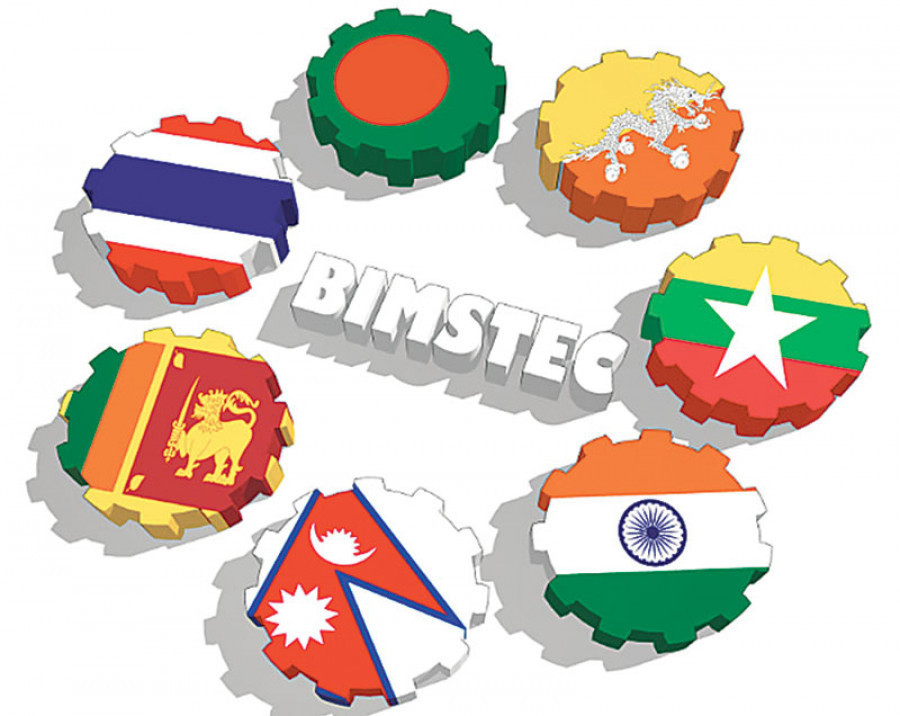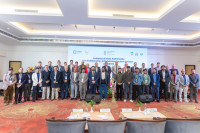National
Two decades on, BIMSTEC still struggles for relevance
In the last 24 years, BIMSTEC has held just four summit meetings. The Sri Lanka summit remains uncertain due to Covid.
Anil Giri
While its effectiveness as a regional cooperation organisation is being questioned, the leaders of the seven member states of the Bay of Bengal Initiative for Multi-Sectoral Technical and Economic Cooperation (BIMSTEC) have pledged to work together to fight the Covid-19 pandemic.
The pledge was made by the leaders of the member states — Nepal, India, Bhutan, Bangladesh, Sri Lanka, Myanmar and Thailand — by issuing statements on Sunday on the occasion of the 24th anniversary of the regional grouping.
Prime Minister KP Sharma Oli issued a statement on the occasion expressing his commitment to use BIMSTEC as a platform to combat multiple challenges facing the region including the devastating pandemic.
Prime Minister Oli said he believes that vaccination is the key to fighting the Covid-19 pandemic and that the BIMSTEC should make joint efforts to ensure that the member states have timely and affordable access to COVID-19 vaccines.
“I hope that the upcoming BIMSTEC Summit will be a milestone for institutional strengthening and intensification of multi-sectoral cooperation among the member states, including through the adoption of the BIMSTEC Charter,” the Prime Minister said in his statement.
BIMSTEC, which is seen as a competitor of another regional organisation, the South Asian Association for Regional Cooperation (SAARC), only recently finalized its charter in September last year, 23 years after its inception. As SAARC, which was formed in 1985, remains in a limbo since 2016 when it was unable to hold its 19th summit meeting amid tensions between India and Pakistan, experts have expressed fears that BIMSTEC could meet a similar fate as it could not hold even a single meeting during the past one year and a half to discuss ways to tackle the Covid-19 pandemic.
In the last 24 years, BIMSTEC has held just four summit meetings.
As the current chair of the grouping, it is Sri Lanka’s turn to hold the fifth summit, which remains uncertain due to the pandemic.
“When SAARC became defunct, BIMSTEC was created as an alternative platform, but it has also failed to take off properly,” former Nepali ambassador to Geneva Shambhu Ram Simkhada said, adding, “For any organisation to become successful, there must be a consensus among the member states on minimum political values and common security threats.”
Just like the SAARC charter, the BIMSTEC tradition also bars member states from discussing bilateral or contentious issues.
Although the member states cannot discuss security and political issues, there is a general consensus on combating terrorism.
BIMSTEC covers 14 areas of cooperation from climate change, terrorism to poverty alleviation and each member states are assigned to lead one theme. It has yet to form various mechanisms and bodies but according to officials, it is more or less copying the SAARC model for setting up organisations, mechanisms and regional sub-bodies. And the objectives are also more or less similar.
“Out of the 14 areas of cooperation, public health is one area where member states have decided to cooperate with each other under the BIMSTEC framework. But, we hardly had a meeting to discuss a modality for cooperation,” a senior government official said, adding, “Then what’s the use of identifying public health as an area of cooperation”
Politically, BIMSTEC is a bridge between South Asia and East Asian countries where many see BIMSTEC as an organisation minus Pakistan. One reason that SAARC could not move ahead is the longstanding rivalry between India and Pakistan.
“Undoubtedly, India sidelined SAARC and pushed ahead with BIMSTEC,” Dinesh Bhattarai, former Nepali ambassador and advisor to two former prime ministers, said. “But due to the Covid-19 pandemic, I think India’s priority might have shifted.”
“Sooner or later, after the pandemic passes, I think, BIMSTEC will gain momentum. But BIMSTEC cannot replace SAARC and cannot be its alternative because SAARC has done a lot of work down to the people’s level,” he said, adding, “Now that BIMSTEC has its charter, let's hope it will move ahead.”
But not everyone is hopeful. Some experts and observers say that if any organisation runs without a dedicated Charter, objective and vision for 23 years, it can’t be called successful.
“BIMSTEC has failed to conceptualize itself. It has higher expectations but it has lost its vision. Member states do not have any expectations from it. A lot needs to be done to make it a vibrant regional organisation like other regional organisations. This organisation needs to be revamped and revisited,” said Prof Sridhar Khatri, who headed some regional organisations in Kathmandu and Colombo.
“There has to be life and momentum in regional organisations, which we see in the EU and somehow SAARC in the past had this, but BIMSTEC has largely lost that momentum.”
But there are observers who see BIMSTEC as an organisation that is reviving and making a good push.
Among them is Constantino Xavier, a fellow at Social and Economic Progress, a New Delhi based think tank, who said that despite its limited capacity BIMSTEC is doing better than before. “Regional organisations are not just a collection of individual initiatives and interests. They have to be empowered with finances, resources and autonomy to implement their mandates. In terms of connectivity, BIMSTEC is now taking a lead on various transportation and other initiatives to connect the Himalayas to the Bay of Bengal and beyond. This is a priority for economic growth in the region: trade cannot happen without better road, rail, river, port and air connectivity, and that can only be achieved if states cooperate through BIMSTEC rather than acting individually or bilaterally,”
Xavier also lauded Nepal for successfully hosting the BIMSTEC summit in 2018.
The Kathmandu declaration represents a new vision for regionalism and includes several steps to strengthen the organisation, especially the Secretariat, he said.
“Budgetary allocations have increased, there is a new charter establishing rules, the number of country directors has increased, and the number and range of working groups is being rationalized,” said Xavier. “Also, in terms of summits and meetings, there is a new regularity, including the recent ministerial, after many years of delays and interruptions.”
But Simkhada, the former Nepali ambassador to Geneva, is not much optimistic with the existing arrangements.
“A secretariat headed by a joint secretary or ambassador cannot lead BIMSTEC. How can a joint secretary or ambassador who is the secretary general of BIMSTEC go and talk to heads of states and governments and outline the road map and implement the vision? The post of secretary general should be empowered and should be elevated to the political level,” he said.
As Kathmandu hosts the Secretariat of SAARC, the Bangladeshi Capital Dhaka hosts the BIMSTEC secretariat. Each member country has an undersecretary-level representation at the BIMSTEC Secretariat and on top of that, a secretary general heads the organisation.
“On the policy front, member countries should have at least minimum consensus on economic, political and security issues. Every member state should give up their narrow national interest and the national interest of all member states should be harmonised,” said Simkhada.




 11.12°C Kathmandu
11.12°C Kathmandu















